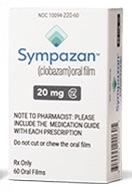Sympazan Dosage
Generic name: CLOBAZAM 5mg
Dosage form: oral film
Drug class: Benzodiazepine anticonvulsants
Medically reviewed by Drugs.com. Last updated on Mar 12, 2024.
Dosing Information
A daily dose of SYMPAZAN® greater than 5 mg should be administered in divided doses twice daily; a 5 mg daily dose can be administered as a single dose. Dose patients according to body weight. Individualize dosing within each body weight group, based on clinical efficacy and tolerability. Each dose in Table 1 (e.g., 5 to 20 mg in 30 kg or less weight group) has been shown to be effective, although effectiveness increases with increasing dose [see Clinical Studies (14)]. Do not proceed with dose escalation more rapidly than weekly, because serum concentrations of clobazam and its active metabolite require 5 and 9 days, respectively, to reach steady-state.
| Table 1: Recommended Total Daily Dosing by Weight Group | ||
| 30 kg or Less Body Weight | Greater than 30 kg Body Weight | |
| Starting Dose | 5 mg | 10 mg |
| Starting Day 7 | 10 mg | 20 mg |
| Starting Day 14 | 20 mg | 40 mg |
Discontinuation or Dosage Reduction of SYMPAZAN
To reduce the risk of withdrawal reactions, increased seizure frequency, and status epilepticus, use a gradual taper to discontinue SYMPAZAN or reduce the dosage. Taper by decreasing the total daily dosage by 5-10 mg/day on a weekly basis until discontinued. If a patient develops withdrawal reactions, consider pausing the taper or increasing the dosage to the previous tapered dosage level. Subsequently decrease the dosage more slowly [see Warnings and Precautions (5.3) and Drug Abuse and Dependence (9.3)].
Important Administration Instructions
Instruct patients and/or caregivers to read the “Instructions for Use” carefully for complete directions on how to properly dose and administer SYMPAZAN® oral films.
Apply SYMPAZAN® on top of the tongue where it adheres and dissolves.
SYMPAZAN® oral film can be taken with or without food [see Clinical Pharmacology (12.3)]. Do not administer with liquids. As the film dissolves, saliva should be swallowed in a normal manner, but the patient should refrain from chewing, spitting or talking.
Only one oral film should be taken at a time; if a second film is needed to complete the dosage, it should not be taken until the first film has completely dissolved.
Dosage Adjustments in Geriatric Patients
Plasma concentrations at any given dose are generally higher in geriatric patients [see Clinical Pharmacology (12.3)]. Therefore, the starting dosage should generally be 5 mg/day for all geriatric patients. Then proceed slowly with dose escalation; titrate according to weight, but to half the dosage presented in Table 1, as tolerated. If necessary and based upon clinical response, an additional titration to the maximum dosage (20 mg/day or 40 mg/day, depending on weight) may be started on day 21 [see Use in Specific Populations (8.5)].
Dosage Adjustments in CYP2C19 Poor Metabolizers
In CYP2C19 poor metabolizers, levels of N-desmethylclobazam, clobazam's active metabolite, will be increased [see Clinical Pharmacology (12.5)]. Therefore, the starting dosage should be 5 mg/day in patients known to be CYP2C19 poor metabolizers. Then proceed slowly with dose escalation; titrate according to weight, but to half the dosage presented in Table 1, as tolerated. If necessary and based upon clinical response, an additional titration to the maximum dosage (20 mg/day or 40 mg/day, depending on weight) may be started on day 21 [see Use in Specific Populations (8.6)].
Dosage Adjustments in Patients with Hepatic Impairment
SYMPAZAN® is hepatically metabolized; however, there are limited data to characterize the effect of hepatic impairment on the pharmacokinetics of SYMPAZAN®. For patients with mild to moderate hepatic impairment (Child-Pugh score 5-9), the starting dosage should be 5 mg/day (regardless of weight). Then proceed slowly with dosing escalations; titrate patients according to weight, but to half the dosage presented in Table 1, as tolerated. If necessary and based upon clinical response, an additional titration to the maximum dosage (20 mg/day or 40 mg/day, depending on weight) may be started on day 21. There is inadequate information about metabolism of clobazam in patients with severe hepatic impairment. Therefore, no dosing recommendation can be given for those patients [see Use in Specific Populations (8.8), Clinical Pharmacology (12 .3)].
Frequently asked questions
More about Sympazan (clobazam)
- Check interactions
- Compare alternatives
- Pricing & coupons
- Drug images
- Latest FDA alerts (3)
- Side effects
- During pregnancy
- FDA approval history
- Drug class: benzodiazepine anticonvulsants
- Breastfeeding
- En español
Patient resources
Other brands
Professional resources
Other brands
Related treatment guides
Further information
Always consult your healthcare provider to ensure the information displayed on this page applies to your personal circumstances.

